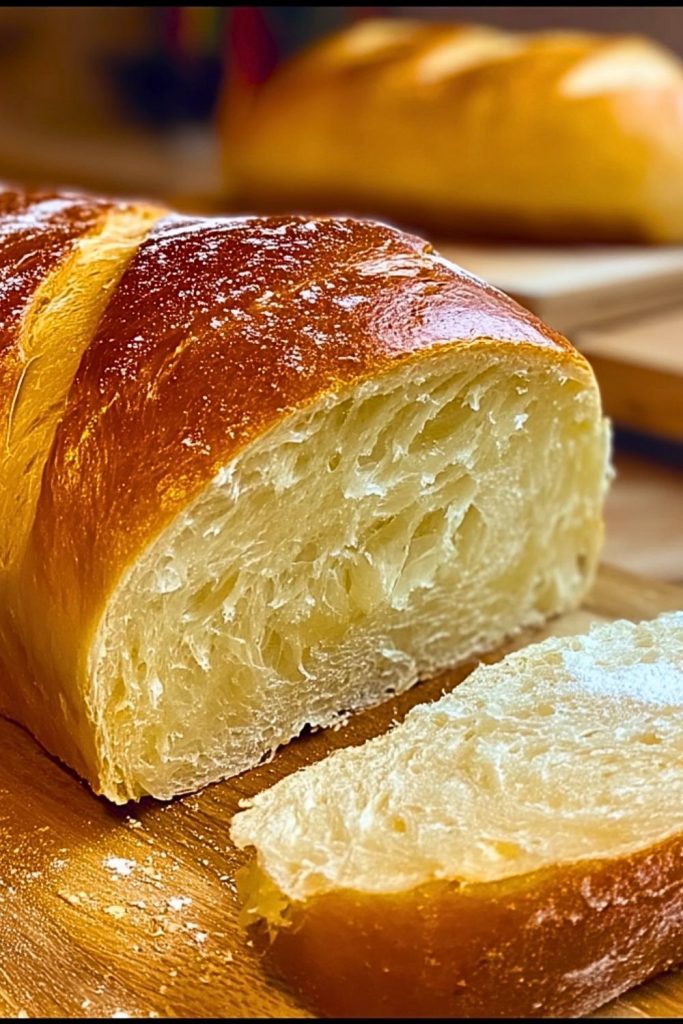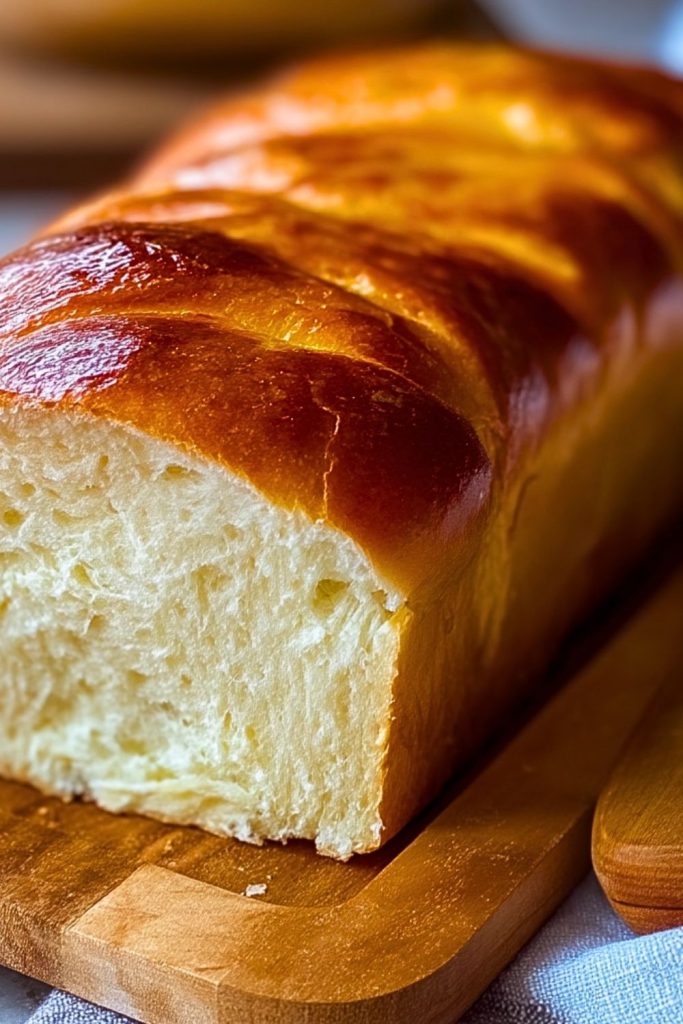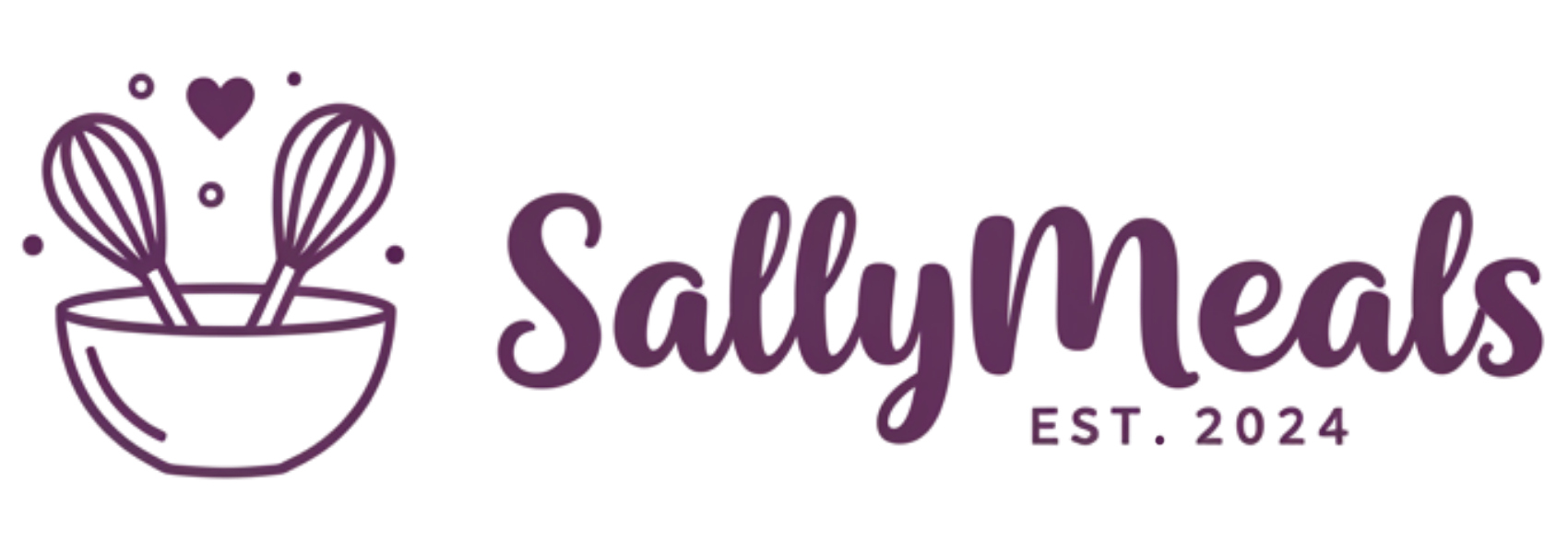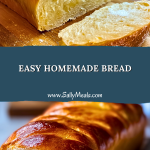Baking bread at home is something I always come back to when I want comfort and warmth in the kitchen. There’s nothing like the aroma of freshly baked bread wafting through the house—it instantly turns any day around. This Easy Homemade Bread is my go-to when I want something reliable, soft, and beautifully golden on top, with just the right amount of chew on the inside.

I love how this recipe feels both nostalgic and rewarding. Whether you’re a beginner or someone who’s been baking for years, making bread from scratch offers a kind of joy that you just can’t buy at the store. This particular loaf, with its glistening crust and airy interior, is perfect for everything from morning toast to sandwich bases or simply slathered in butter while still warm.
Why You’ll Love This Easy Homemade Bread
- Beginner-Friendly: No special techniques or rare ingredients needed—just pantry basics and a little patience.
- Soft and Fluffy Texture: Thanks to the perfect balance of ingredients and rise time, the inside is pillowy and light.
- Golden Crust: Brushed with egg wash, the top turns glossy and golden-brown, giving it that bakery-style finish.
- Versatile: This bread pairs beautifully with sweet or savory toppings and can be used for sandwiches, French toast, or just eaten plain.
- Homemade Goodness: Free from preservatives and packed with the satisfaction of knowing exactly what goes into it.
What Type of Flour Should I Use for Easy Homemade Bread?
For this Easy Homemade Bread, I typically use all-purpose flour, which strikes the right balance between texture and ease. It’s readily available and produces a tender, fluffy crumb while still giving structure to the loaf. However, if you’re after a slightly chewier, more artisan-style texture, bread flour is a great alternative—it has higher protein content, which helps develop more gluten for a firmer bite.
Avoid using whole wheat flour on its own in this recipe unless you’re adjusting for hydration. Whole wheat flour absorbs more water and can result in a denser loaf if not tweaked properly. But blending a bit of it (say, 25-30%) with white flour adds a touch of nuttiness without compromising the texture too much.
Options for Substitutions
One of the reasons I love this recipe is how adaptable it is. Here are some smart swaps you can consider:
- Milk instead of water: Using warm milk in place of water adds richness and makes the bread even softer.
- Honey or maple syrup instead of sugar: These natural sweeteners bring a subtle flavor shift and work beautifully in the dough.
- Olive oil instead of butter: If you want a dairy-free version or prefer a Mediterranean touch, olive oil is a great alternative.
- Egg wash alternatives: You can use milk or cream to brush the top if you’re avoiding eggs—it’ll still give a nice sheen, though less vibrant.
- Yeast options: Instant yeast can be used instead of active dry yeast. Just remember to skip the blooming step and mix it directly with the flour.
Ingredients for Easy Homemade Bread
Every ingredient in this bread plays a role in building its perfect texture, flavor, and golden finish. Here’s a breakdown of what you’ll need and why it matters:
- All-Purpose Flour: This forms the structure of the bread, giving it body and softness. It’s the base of the recipe and works well for a light, tender crumb.
- Warm Water: Helps activate the yeast and brings the dough together. The temperature should be just warm to the touch—not hot—to avoid killing the yeast.
- Active Dry Yeast: The leavening agent that makes the bread rise. It creates those airy pockets inside and helps develop that beautiful height.
- Granulated Sugar: Just a touch is used to feed the yeast and add a hint of sweetness to balance the flavor.
- Salt: Enhances all the flavors and also strengthens the dough’s structure during kneading.
- Unsalted Butter: Adds richness and softness to the crumb while giving a slightly buttery flavor.
- Egg (for the wash): Brushed on top before baking, it gives the crust that irresistible golden, glossy finish.
Each element plays its part, resulting in a loaf that’s soft, slightly sweet, and utterly comforting.

Step 1: Activate the Yeast
In a large mixing bowl, combine warm water (about 110°F/43°C) with the sugar and sprinkle the active dry yeast on top. Let it sit for 5–10 minutes until it turns foamy. This means the yeast is alive and ready to work its magic. If it doesn’t foam, the yeast may be expired—start again with fresh yeast.
Step 2: Mix the Dough
Add the flour and salt to the bowl with the activated yeast. Begin mixing using a wooden spoon or the dough hook on a stand mixer. Once it starts coming together, add the softened butter and continue kneading until a soft, elastic dough forms. This usually takes 8–10 minutes by hand or 5–6 minutes in a stand mixer.
Step 3: First Rise
Transfer the dough to a lightly greased bowl, cover it with a clean kitchen towel or plastic wrap, and let it rise in a warm place for 1 to 1.5 hours, or until it has doubled in size. A warm, draft-free spot (like inside an unheated oven with the light on) works great.
Step 4: Shape the Dough
Punch down the risen dough gently to release the air. Turn it out onto a floured surface and shape it into a loaf. You can place it in a greased loaf pan, or braid it for a decorative touch and place it in the pan afterward.
Step 5: Second Rise
Cover the shaped dough again and let it rise for another 30–40 minutes until puffy and just about doubled. Don’t skip this step—it gives the loaf a tender, airy interior.
Step 6: Egg Wash & Bake
Preheat your oven to 350°F (175°C). Brush the top of the dough with a beaten egg for that golden, glossy finish. Bake for 30–35 minutes, or until the top is deep golden and the bread sounds hollow when tapped.
Step 7: Cool Before Slicing
Let the bread cool in the pan for about 10 minutes, then transfer to a wire rack to cool completely. This helps set the crumb and makes slicing easier.
How Long to Cook Easy Homemade Bread
Baking time for this Easy Homemade Bread is typically 30 to 35 minutes in a preheated 350°F (175°C) oven. You’ll know it’s done when:
- The crust is deeply golden and shiny from the egg wash.
- It sounds hollow when tapped gently on the bottom.
- An internal temperature of 190–200°F (88–93°C) confirms it’s fully baked.
If the top browns too quickly before the inside is done, loosely tent the bread with foil in the last 10–15 minutes to prevent over-browning.
Tips for Perfect Easy Homemade Bread
Here’s how to make sure your loaf turns out bakery-worthy every time:
- Use warm—not hot—water: The ideal range is 105–110°F to activate yeast without killing it.
- Measure your flour accurately: Spoon it into the cup and level it off, or use a kitchen scale if you have one.
- Knead long enough: Proper kneading builds gluten, which gives structure and elasticity. The dough should be smooth and slightly tacky.
- Don’t rush the rise: Let the dough rise until it doubles, not just for the time listed—dough responds to conditions, not clocks.
- Control your environment: If your kitchen is cold, use your oven (turned off) with the light on for a cozy rise.
- Use fresh yeast: If your yeast doesn’t bubble during activation, it won’t rise. Always check the expiration date.
- Cool fully before slicing: Cutting too soon will result in gummy slices. Letting it rest keeps the texture light and fluffy.
- Customize the finish: For an ultra-shiny top, you can double brush with egg wash—once before baking, once halfway through.
Watch Out for These Mistakes While Cooking
Even the simplest bread recipe can go sideways with just a few missteps. Here’s what to avoid when making Easy Homemade Bread:
- Skipping the yeast proofing: If your yeast isn’t active, the dough won’t rise. Always check for that foamy bloom before continuing.
- Adding too much flour: It’s tempting to keep adding flour if the dough feels sticky, but too much will make the bread dense and dry.
- Under-kneading or over-kneading: Not kneading enough results in weak structure, while over-kneading (especially in a mixer) can make the bread tough.
- Incorrect rise timing: Cutting the rising time short prevents the dough from developing flavor and structure. Let it double, even if it takes longer.
- Cold baking environment: Yeast loves warmth. If your dough is sitting in a cold spot, it will rise slowly or not at all.
- Not preheating the oven: Bread needs consistent heat from the start. Always preheat fully before baking.
- Forgetting the egg wash: That glossy, golden crust comes from this step—don’t skip it unless substituting intentionally.
- Slicing too soon: Cutting into hot bread compresses the structure and turns the inside gummy. Let it cool completely on a wire rack.
What to Serve With Easy Homemade Bread?
This bread is incredibly versatile and works beautifully across meals and moods. Here are eight serving ideas to try:
Tomato Basil Soup
A classic combo—dip a warm slice into a bowl of creamy, herby tomato soup for ultimate comfort.
Scrambled Eggs and Avocado
Turn it into a brunch superstar by toasting and topping with fluffy eggs and ripe avocado.
Butter and Jam
Sometimes the simple things are best. A thick slice with butter and your favorite jam is timeless.
Grilled Cheese Sandwich
Use it for a crispy, golden grilled cheese—its structure holds up well when pan-toasted.
Fresh Garden Salad
Balance it with something light. Serve a slice or two alongside a green salad for a clean, refreshing plate.
Pasta with Marinara
Mop up that sauce! The chewy interior makes this bread perfect for sopping up flavorful pasta sauces.
Garlic Bread Twist
Slice and brush with garlic butter, then broil for a quick homemade garlic bread.
Afternoon Tea or Coffee
Enjoy a buttered piece with your afternoon coffee or tea for a cozy snack break.
Storage Instructions
To keep your Easy Homemade Bread fresh and delicious, follow these simple storage tips:
- Room Temperature: Store the fully cooled bread in a bread box or wrap it tightly in foil or plastic wrap and keep it at room temperature for up to 3 days. Avoid refrigerating—it dries out the crumb faster.
- Freezing: For longer storage, slice the bread and freeze it. Wrap individual slices or the whole loaf tightly in plastic wrap and place in a freezer-safe bag. It’ll keep well for up to 3 months. Just toast or warm up slices as needed—no thawing required.
- Reheating Tips: Warm slices in a toaster, or pop the whole loaf in a 300°F (150°C) oven for 10–15 minutes to refresh its just-baked texture.
Estimated Nutrition (per slice, based on 12 slices per loaf)
Here’s a general breakdown for one slice of this classic homemade bread. Keep in mind values may vary slightly based on your exact ingredients:
- Calories: 140
- Carbohydrates: 24g
- Protein: 4g
- Fat: 3g
- Saturated Fat: 1.5g
- Cholesterol: 15mg
- Fiber: 1g
- Sugar: 2g
- Sodium: 200mg
This bread strikes a nice balance—light enough for daily enjoyment but satisfying and nourishing thanks to its wholesome ingredients.
Frequently Asked Questions
What if I don’t have a stand mixer—can I knead by hand?
Absolutely! Kneading by hand is traditional and therapeutic. It might take about 10 minutes of steady folding and pressing, but it works just as well. Look for a smooth, elastic dough that springs back slightly when poked.
Can I use whole wheat flour instead of all-purpose?
Yes, but with some adjustments. Whole wheat flour is denser and absorbs more liquid, so consider using half whole wheat and half all-purpose to keep the bread light. You may also need to add a little more water.
How do I know if my dough has risen enough?
The dough should double in size. A good test is to gently press a finger into it—if the indentation stays, it’s ready. If it springs back quickly, let it rise a bit longer.
Can I add herbs, cheese, or garlic to this bread?
Definitely! Finely chopped fresh herbs, shredded cheese, or roasted garlic can be mixed into the dough during the kneading step. Start with ½ to 1 cup of add-ins to keep the balance.
Is this bread good for sandwiches?
It’s perfect. The soft but structured crumb holds fillings well, and the subtle flavor complements a wide range of sandwich ingredients—from savory meats to crisp veggies.
How do I get that golden crust without eggs?
Brush the loaf with milk or cream instead. It won’t be quite as shiny, but it will still turn beautifully golden and soft.
Can I let the dough rise overnight?
Yes, you can do a cold ferment in the fridge during the first rise. Cover the dough tightly and refrigerate it overnight. This actually improves flavor. Let it come to room temp before shaping.
Why did my bread turn out dense?
Most often, it’s due to under-kneading, expired yeast, or not enough rise time. Make sure your yeast is active, knead until the dough is elastic, and don’t rush the proofing.
Conclusion
There’s something timeless and grounding about baking your own bread. This Easy Homemade Bread recipe makes that experience approachable, rewarding, and downright delicious. Whether you’re slicing it warm to enjoy with butter, stacking it into a sandwich, or serving it with soup, it delivers every time.
What I love most is how customizable it is—simple enough to keep classic, yet flexible enough to dress up with herbs, seeds, or sweet swirls. Once you make it once, you’ll want to keep it in your weekly rotation.

Easy Homemade Bread
- Prep Time: 15 minutes
- Cook Time: 30 minutes
- Total Time: 45 minutes
- Yield: 1 loaf (approx. 12 slices) 1x
Description
There’s something magical about baking bread from scratch—the way the dough rises, the golden crust forms, and that warm, toasty scent fills your kitchen. This Easy Homemade Bread is the perfect recipe for both beginners and seasoned bakers looking for a comforting, reliable loaf. It’s soft, fluffy, and has just the right hint of buttery richness, making it ideal for quick breakfasts, hearty sandwiches, or a cozy side to your favorite dinner. With simple ingredients and minimal prep, it’s one of the best food ideas to keep in your rotation. Whether you’re looking for an easy recipe or fresh dinner ideas, this loaf will deliver every time.
Ingredients
- 3 1/2 cups all-purpose flour
- 1 cup warm water (110°F / 43°C)
- 2 1/4 tsp active dry yeast (1 packet)
- 2 tbsp granulated sugar
- 1 1/2 tsp salt
- 2 tbsp unsalted butter, softened
- 1 egg (for egg wash)
Instructions
- In a large bowl, combine warm water and sugar. Sprinkle yeast on top and let it sit for 5–10 minutes until foamy.
- Add flour and salt. Mix until a shaggy dough forms, then knead in the softened butter.
- Knead by hand for 8–10 minutes (or 5–6 minutes in a stand mixer) until the dough is smooth and elastic.
- Place in a greased bowl, cover, and let rise for 1 to 1.5 hours or until doubled.
- Punch down the dough, shape into a loaf, and place in a greased loaf pan.
- Cover and let rise again for 30–40 minutes, until puffy.
- Preheat oven to 350°F (175°C). Brush the top with beaten egg.
- Bake for 30–35 minutes until golden brown and the loaf sounds hollow when tapped.
- Cool in pan for 10 minutes, then transfer to a wire rack to cool completely.

